![]() Philosophy & Interests
Philosophy & Interests
![]() Research Program
Research Program
Research Interests...
Evolutionary Ecology of Plant - Insect Interactions
Contents
Philosophy & Interests
Research Program
I have only a single philosophy:
Learning
To live is to learn and we continue learning until we stop learning and we die. Every day is, simply, a fresh chance to learn something new.
The best way to teach anything is through experience, which, conveniently I think, is also the best way to learn. Tell a student a fact or idea in a lecture and that factoid will go in one ear and out the other, ask them to read it and it will embed the content in their brain until the next test, but help them to experience the fact or idea and they’ll retain it for the rest of their lives.
Teaching, therefore, is not about the relaying of facts and information but is about instilling a genuine desire to learn. My role as a teacher is better considered as that of a guide, someone to show students the path, to be a resource that enables students to learn to ask the right question that will lead them to discover their own answers. Any person that masters their own desire to learn ceases to be a student and becomes a “researcher.”
Research, too, is a learning experience. We pose questions, observe, hypothesize, experiment, observe some more, refine our questions, and eventually— through successive iterations of (hopefully) positive feedback, assuming we’ve asked the “right” question—we obtain some answer. Of course, that answer often leads to other questions (but that’s the nature of ecology—if you think you’re done, then you’re not doing ecology). The point is that conducting research is simply teaching oneself through experiential processes, i.e. learning.
Thus, teaching and research are not separate entities but co-exist under a single operating premise: what will I learn today? Asking questions (who, what, when, where and why) is what science is about. The first four are trivial and, at most times, simple to answer through observation and brief study. The hard questions are always “why?” and often involve in-depth observation, experimentation, perturbation of variables/systems and the interpretation of results. “Why?” questions are what keep science interesting!
What will you learn today?
My interests revolve around the evolution and ecology of butterfly/hostplant interactions with a particular leaning towards the Heliconiidae (Argynninae, Heliconiinae, Acraeinae sensu nova) and the Violales (Passifloraceae, Turneraceae, Flacourtiaceae, Violaceae, Caricaceae and Malesherbiaceae) but I have recently begun some work with the mating system of a distylous plant in south Texas.
My current research program is divided into a number of initiatives that examine the evolution of plant chemical defenses and the evolution of host specialization, particularly of insects that are obligate herbivores of particular plant species due to hostplant chemistry.
1. Cyanogenesis in Passiflora incarnata
Passiflora incarnata (Passifloraceae), a common temperate species of a mostly tropical family, has been reported to contain a typical cyclopentenyl cyanogenic glucoside (gynocardin) and the necessary enzymes to hydrolyze the glucoside. Plants from a central Texas location liberated extremely small, almost undetectable, quantities of HCN. Experimental additions of exogenous cyanogenic glucoside and glucosidase revealed that the central Texas plants possessed the enzymes necessary to hydrolyze glucosides, but appeared to largely lack the glucosides themselves.
Holly Scruggs (BIO 377) conducted similar tests of plants from seven widely spaced populations within Texas that provide qualitatively identical results, however a low-level polymorphism (< 50 µg CN-/g dwt tissue) was apparent, seeming to increase from south to north. Further, identical additions of small quantities (50 µl) of cyanogenic glucoside yielded increases in HCN release ranging from 33 to 95 times the amount released from fresh tissue that did not exhibit the same population pattern as raw tissue liberated. She concluded that Passiflora incarnata within Texas possess a very low level polymorphism for cyanogenesis due to limits in the quantity of cyanogenic glucosides that they possess, however, they also show significant variation in the activity or availability of endogenous glucosidases.
Collections of plant populations throughout the natural range of P. incarnata (eastern North America), including Arkansas, Florida, Georgia, Kansas, Kentucky, Louisiana, Missouri, Oklahoma and Tennessee, have been made and assays of this material is in process.
2. Ant Defense of Turnera ulmifolia
The Neotropical plant, Turnera ulmifolia (Turneraceae) possesses a well-documented cyanogenesis polymorphism (Schappert & Shore 1995, 1999a, b, 2000). While much is known about the action of HCN as a defense of this species against invertebrate herbivores, the plants also possess extrafloral nectaries and seeds with elaiosomes or accessory protein bodies that are attractive to ants. These traits are associated with ant defense and ant transport of seeds (myrmecophily and myrmecochory respectively; Keeler 1989). Ants, social insects of the Hymenoptera (family Formicidae), are voracious predators of invertebrates. Plants with traits that attract and provide rewards to ants gain a “pugnacious bodyguard” since ants will frequently attack and consume any herbivore that attempts to feed on the plant. Ants defending their “resources” simultaneously defend the plant providing the resources.
A significant pretest of this research was completed by Sara Pratt (BIO 377). Her project asked 1) do ants defend plants of T. ulmifolia?, and 2) do ant and chemical defenses interact. Two plots of 36 plants, 18 acyanogenic and 18 cyanogenic plants (3 genotypes of each), were arrayed in the field in similar situations in an alternating design (6x6 arrays, acy/cy/acy, etc., so each plants nearest neighbors were plants of the opposite cyanotype). Plants were elevated on pedestals coated with a Tanglefoot barrier and surrounding vegetation was removed to prevent ant access to all plants. One-half of the plants, equal numbers of each cyanotype, chosen randomly, were provided with 2 twine "ant access roads" to allow access by ants. Reproductive fitness (flower production) was recorded for 100 days.
She found that plants with attendant ants produced more flowers per unit time than plants of the same genotypes that did not have attendant ants. Across genotypes within cyanotypes, ant-tended plants produced significantly more flowers than plants without ants. She also found that there is synergy between HCN and ant defense because cyanogenic plants with attendant ants produced significantly more flowers than any other pairwise (cy/no ants; acy /ants; acy/no ants) comparison. Supporting evidence for these results is shown by correlations between flower production, actual HCN levels and herbivory sustained by the plants: a negative correlation between flower production and herbivory across all plants (P < 0.05); and a positive correlation (P < 0.01) between HCN and flower production on ant defended plants. Flower production correlated negatively (P < 0.01) with HCN on low HCN plants, regardless of ant attendance.
Since cyanogenic glycoside production exerts a significant flowering fitness cost on plants under controlled conditions (Schappert & Shore 2000), our finding here that herbivory has a significant effect on flower production overall suggests that herbivory on low HCN plants without ants balances the cost of HCN production. Further, flower production on ant defended low HCN plants does not appear to differ greatly from the no ant treatments, although there is a strong synergism between ant attendance and high HCN levels that appears to greatly offset any cost of cyanogenesis under field conditions.
This research project needs to be scaled up to increase sample size in replicates of single common plots (e.g. 12 x 12 array yielding n=36 in each ant+cyanotype class) with single acy and cy genotypes, to confirm pretest results.
3. Enzyme Inhibition of Cyanogenesis by Tannins
Co-occurring plant defense compounds may interact in one of three ways: They may be mutually benign (have little or no effect on one another), synergistic (have a positive effect on plant defense due to their co-occurrence), or antagonistic (produce a negative effect on plant defense due to their co-occurrence). Relatively little research has been conducted on the interactions between co-occurring compounds, although Goldstein & Spencer (1985) have reported on inhibition of cyanogenesis, the ability of plants to liberate hydrogen cyanide (HCN), by tannins. Both classes of compound have been demonstrated to defend plants, however, tannins act as qualitative defenses (digestability-reducing substances) while cyanogenesis is a quantitative defense that acts quickly to deter further herbivory.
Turnera ulmifolia L. (Turneraceae) varies for the presence/absence and quantity of cyanogenic glycosides that they possess (Schappert & Shore 1995). Shore & Obrist (1992), when surveying a number of species of the Turneraceae for cyanogenesis, reported that there was a significant decline in cyanogenesis with leaf age in T. ulmifolia. There are two possible reasons for this variance: 1) active transport mechanisms relocate cyanogenic glycosides from older tissue to fresh tissue in order to enhance defense of new, herbivore-preferred, leaves; or 2) the quantity of available cyanogenic glycosides does not differ between leaves of different ages and some other mechanism is responsible for the decline of HCN release in older leaves.
Cyanogenesis occurs when plant cells are lysed and vacuolar cyanogenic glycosides are released into intercellular spaces where specific β–glycosidases hydrolyze the glycoside to produce an unstable cyanohydrin, which subsequently dissociates spontaneously (or catalyzed by a α-hydroxylyase) to a ketone and HCN. Compartmentation of the two components prevents HCN release until cell walls are broken, thus, cyanogenesis is a useful plant defense whose efficacy in T. ulmifolia was reported by Schappert & Shore (1999). Further, Schappert & Shore (1995, 2000) have shown that the cyanogenesis polymorphism in this species is due to variation in the presence and amount of cyanogenic glycosides (all plants possess the necessary enzymes) and that there is a significant reproductive cost to the production of these glycosides.
Plant tannins also act as defense mechanisms, however, instead of producing a toxic (deterrent) effect, these phenolic compounds have an astringent taste that ultimately serves as a barrier to herbivory by reducing tissue feeding by insect herbivores. There are two main classes, condensed and hydrolysable tannins, which may co-occur or exist independently. Condensed tannins, for example, are common among ferns, gymnosperms, and angiosperms but both classes are found in plant vacuoles.
Goldstein & Spencer (1985) reported that tannins complex with β–glycosidases, thus inactivating them and preventing them from hydrolyzing cyanogenic glycosides. Juntheikki & Julknunen-Tilltto (2000) have also shown that tannins inhibit the activity of esterases in a number of taxa. Therefore, the hypothesis that the availability of cyanogenic glycosides does not change but that inhibition of β–glucosidases by tannins prevents some of the available cyanogenic glycosides from being hydrolyzed seems tenable.
Investigations of the decline in HCN liberated by older leaves of T. ulmifolia have confirmed, using a more sensitive quantitative assay, Shore & Obrist’s 1992 report of a decline in HCN release with increasing leaf age and that the quantity of total phenolics (i.e., tannins as gallic acid equivalents) increases with leaf age. The third necessary component of this research, quantifying that the availability of cyanogenic glycosides in fresh and mature leaves dies not differ has yet to be completed.
4. Cyanogenesis in Turnera diffusa and its Commercial Products
Damiana, the common name for Turnera diffusa, is a commonly available "herbal supplement" that has alleged aphrodisiac properties. However, pharmacologist Varro E. Tyler wrote a scathing expose of this apparently self-perpetuating “herbal hoax.” (see Pharmacy in History 25: 55-60). Tests of live--and dried--tissue of T. diffusa foliage and plant parts show that all woody and chlorophyllous tissue is highly cyanogenic. This research tests for the presence of HCN in commercially available products--capsules, tinctures, teas, etc.--and compares it to the yield of HCN from collections made in south Texas.
Preliminary results show that dry products (capsules, tea) contain high levels of liberated HCN even without the addition of exogenous enzymes. Calculations from these results suggest that levels as high as the LD50 of a Norway rat may be consumed daily by following the "dosage" instructions. The long term effects of sub-lethal doses of HCN from this source are not known. As of this time, the only safe products are those were extracts of the tissues have been adsorbed onto inert carriers such as cellulose (however, the extraction process has also likely rendered any "value" of the product moot). Final assays of HCN levels of the many product "versions" available, and assays of alcoholic and non-alcoholic tinctures and prepared tea, remain to be completed.
5. Responses of related generalist and specialist insects to quantitative allelochemical variation
Testing hypotheses that suggest that adaptations to host-specific chemicals are important factors in the evolution of host specialization has been hampered by the necessity of using either multi-species host arrays that differ qualitatively in chemistry - thus confounding chemistry with hostplant species differences - or using comparative techniques to compare unrelated insects on two or a few species of hosts. It has not been possible to study the responses of closely-related insects which differ in their degree of hostplant specificity on a single species of host which varies quantitatively for hostplant defense chemical. The extensive quantitative cyanogenesis polymorphism of Turnera ulmifolia L. (Turneraceae) and the presence of two closely-related herbivores which differ markedly in their patterns of host use, Euptoieta hegesia Cramer and E. claudia Cramer (Lepidoptera: Nymphalidae), offers such an opportunity.
Euptoieta hegesia uses Turnera ulmifolia as its primary hostplant although it is also known to accept a variety of species of Passiflora (Passifloraceae) and Violaceae (esp. Hybanthus) as secondary hostplants throughout its range while E. claudia is known to feed on these three taxa (Turnera, Passiflora, and Viola) as well as representatives of at least seven other unrelated plant families (e.g. Linum (Linaceae), Desmodium (Fabaceae) and others). All available evidence suggests that the Turneraceae, Passifloraceae and Violaceae are themselves closely related which further suggests that the difference between E. hegesia and E. claudia is the use of unrelated families of plants by E. claudia. Further, all available evidence suggests that Euptoieta is closely related to the Heliconiinae which are obligate herbivores of Passiflora sp. (except for a single report of a primitive Heliconiid that feeds on a member of the Turneraceae). The cyanogenic chemistry of T. ulmifolia and some Passiflora sp. (especially P. foetida L., P. perfoliata L., and P. suberosa L.) are virtually identical.
I am examining the effects of the cyanogenic chemistry of T. ulmifolia and these three species of Passiflora on the growth, development and host use of E. hegesia, E. claudia, and the primitive Heliconiid, Agraulis vanillae L. in controlled laboratory (growth, development and host choice) and field (growth, host choice) experiments. The herbivores are from Jamaica, Costa Rica, and northern Mexico or southern Texas. On Jamaica, E. hegesia encounters the cyanogenesis polymorphism in T. ulmifolia as well as using all three Passiflora sp., however, E. hegesia from Costa Rica only encounter a relatively acyanogenic diploid Turnera sp. plus two of the three Passiflora sp. and those from northern Mexico/southern Texas use local species of Passiflora. Similarly, E. claudia on Jamaica uses Viola patrinii DC. with possible use of one of the three Passiflora sp. but those from northern Mexico/southern Texas use Linum sp. and a local Passiflora sp. Agraulis vanillae is not known to feed on T. ulmifolia and uses only Passiflora sp. as hosts.
I expect these experiments to 1) help to delineate the differences between generalists and adapted vs. non-adapted specialists in their responses to quantitative variation in cyanogenesis in T. ulmifolia, 2) assess the induction of feeding preferences in comparison to performance on related hosts with varying chemistry, and 3) provide insights into the evolution of quantitative variation for cyanogenesis as a plant defense.
6. Pollination Biology of distylous Turnera diffusa in South Texas.
Turnera diffusa, a distylous sub-shrub from the Neotropics, is found in 4 counties (Hidalgo, Jim Hogg, Starr and Zapata) in south Texas. It is self- and intramorph-incompatible (Joel Shore, pers. comm.), thus it is an obligate outcrosser requiring insects or other pollinators to transport pollen between opposing flora morphs. Morph frequencies of 4 populations do not differ from 1:1. Preliminary observations of pollinators (type, ID, fidelity, visit frequency etc.) is currently being conducted. Photos
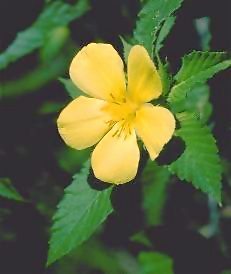
Above: Flower of Turnera ulmifolia var. angustifolia L. (Turneraceae) near Southfield, Jamaica, December 1995.
Right: Anolis lineatopus Gray (Squamata), a significant predator of E. hegesia larvae and adults on Jamaica, at Discovery Bay, Jamaica, June 1991.
Far Right: Larva of E. hegesia feeding on flower of T. ulmifolia near Southfield, Jamaica, December 1995.
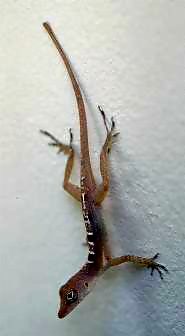
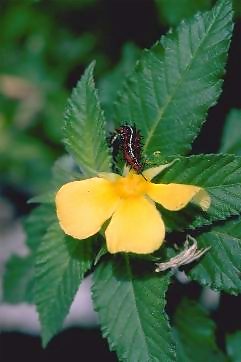
Above: Euptoieta hegesia Cramer (Nymphalidae) ovipositing on T. ulmifolia near Sandy Bay, Jamaica, June 1990.
Right: Mating pair of Euptoieta claudia Cramer (Nymphalidae) near Cinchona, Jamaica, August 1991.
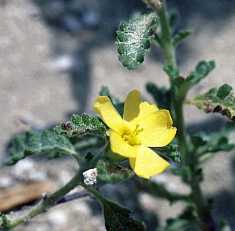
Above: Long morph of Turnera diffusa near Roma in south Texas
Right: Short morph.
Far right: Larva of E. hegesia on T. diffusa at La Puerta.
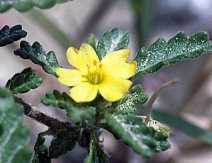
Refereed:
Schappert, P. J. & J. S. Shore (2000). Cyanogenesis in Turnera ulmifolia L. (Turneraceae). II. Developmental expression, heritability and cost of cyanogensis. Evolutionary Ecology Research 2000(2): 337-352. (abstract)
Schappert, P. J. & J. S. Shore (1999). Cyanogenesis, herbivory and plant defense in Turnera ulmifolia on Jamaica. Ecoscience 6: 511-520. (abstract)
Schappert, P. J. & J. S. Shore (1999). Effects of cyanogenesis polymorphism in Turnera ulmifolia on Euptoieta hegesia and potential Anolis predators. Journal of Chemical Ecology 25: 1455-1479. (abstract)
Schappert, P. J. & J. S. Shore, 1998. Ecology, population biology and mortality of Euptoieta hegesia Cramer (Nymphalidae) on Jamaica. Journal of the Lepidopterists' Society 52: 9-39. (abstract)
Schappert, P. J. & J. S. Shore, 1995. Cyanogenesis in Turnera ulmifolia L. (Turneraceae). I. Phenotypic distribution and genetic variation for cyanogenesis on Jamaica. Heredity 74: 392-404. (abstract)
Other:
Books:
Schappert, P. J. (2004). Monarch Butterflies: saving the King of the New World. (book, Key Porter/ WWF Canada, 128 pp.).
Schappert, P. J. (2000). A World for Butterflies: their lives, behavior, and future. (book, Key Porter Books/Firefly Books, Toronto, 320 pp.).
Book Chapters/Articles/Reports:
Schappert, P. J. (2005). Winter Butterflies of the Lost Pines. News of the Lepidopterists’ Society 47(1): 32-33, 40.
Schappert, P. J. (2004). Bring in Butterflies. Mother Earth News, June/July 2004, pp. 64-66.
Schappert, P. J. (2004). Strange Attractors: Coastal Sandbur, Cenchrus spinifex (Poaceae). News of the Lepidopterists’ Society 46(4): 126-128.
Schappert, P. J. (2003). Identification and Distribution of the Passiflora of Texas. Native Plant Society of Texas News 22(4): 4-5.
Mansouri, R. & Schappert, P. J. (2003). Cyanogenesis in Passiflora incarnata: a preliminary report. Passiflora 13(1): 22-23.
Schappert, P. J. (2003). Damiana , Sex and the Fritillary: the real story. Native Plant Society of Texas News 21(4): 4-5.
Schappert, P. J. (2003). Turning Your Yard Into a Butterfly Sanctuary. pp. 35-40 in The Butterfly Gardener’s Guide, Dole, C. H. (ed.), Brooklyn Botanical Gardens, NY.
Schappert, P. J. (2001). Butterfly Buffet. Natural History, July/August 2001, pp. 46-49.
Schappert, P. J., 1996. Distribution, Status and Conservation of the Monarch butterfly, Danaus plexippus (L.), in Canada. Consultant's Report (NAFTA) submitted to the Commission for Environmental Cooperation, Montréal, Québec, 20 pp.
Schappert, P. J., 1994. Flying Flowers, Bruce Trail News, Summer 1994, pp. 12-17.
Schappert, P. J., 1992. Watching Butterflies, pp. 69-70 in Kawarthas Nature, Peterborough Field Naturalists, Boston Mills Press.
Schappert, P. J., 1990. Talking Wings, Seasons, Summer 1990, pp. 20-25.
2004: 55th Annual Meeting of the Lepidopterists’ Society, College Park, MD, “Butterflies of the Stengl “Lost Pines” Biology Station.” (poster)
2001: 52nd Annual Meeting of the Lepidopterists’ Society, Corvallis, OR, “Population dynamics of concurrent host use by Agraulis vanillae L. and Euptoieta claudia Cramer (Nymphalidae) in central Texas”.
1998: 3rd International Butterfly Ecology and Evolution Symposium, Rocky Mountain Biological Laboratory, Mt. Crested Butte, Colorado, “Predation and defense of Euptoieta hegesia (Nymphalidae)” (poster)
1996: 47th Annual Meeting of the Lepidopterists' Society, Houston, Texas, USA, "Cyanide & Butterflies II: ecology, mortality and tritrophic interactions." (received Harry K. Clench Memorial Award)
1995: Society for Evolution Meeting, Montreal, PQ, also Phytochem. Soc. of N. Am. Meeting, Sault Ste. Marie, Ont., "Cyanogenesis in Turnera ulmifolia L. (Turneraceae): mediating interactions at multiple levels"
(Pat and I at the Phytochemical Society meeting, 1995. Photo by Adolf Nahrstedt)
1994: Am. Inst. Biol. Sci. Conference, Ames, Iowa, USA, "Cyanogenesis in Turnera ulmifolia L. (Turneraceae): phenotypic distribution and genetic variation for cyanogenesis on Jamaica"
1992: 43rd Annual Meeting of the Lepidopterists' Society, Lansing, MI, USA, "Cyanide and butterflies: a tale of herbivory in a Jamaican weed"; Ontario Ecology and Ethology Colloquium, Peterborough, Ont., "Cyanide-mediated coevolution in a Jamaican hostplant-herbivore system"
1991: 1st Annual Meeting of the Association for Tropical Butterflies, Gainesville, FL, USA, "The Biology of Euptoieta hegesia (Nymphalidae) on Jamaica" and "The size and shape of butterfly wings: on the relationship between mate-location behaviour and wing morphology"
Canadian Journal of Botany Entomologia Experimentalis et Applicata
Evolutionary Ecology Research Functional Plant Biology
Journal of Biosciences Journal of Chemical Ecology
Journal of the Lepidopterists’ Society Journal of Research on the Lepidoptera
Oecologia Proceedings of the Royal Society: Biol. Sciences.
Tree Physiology
Referee for Books:
Wauer, R. 2002, Butterflies of West Texas Parks and Preserves, Texas Tech Press
Dole, J., Gerard, W. and Nelson, J. 2004, Butterflies of Oklahoma, Kansas, and North Texas. University of Oklahoma Press
Wauer, R. 2006, Finding Butterflies in Texas, Johnson Books, Boulder, CO
Dissertation Committees
Jason Goodger, 2002. Cyanogenesis in Eucalyptus, Ph.D., School of Botany, University of Melbourne, Australia.
Judy Simon, 2006. Defence Strategies in Woody Plants: Effects of cyanogenesis on plant functional characteristics, Ph.D., School of Botany, University of Melbourne, Australia
Undergraduate Research Supervision
Alan Yee, 2006/2007: Cyanogenic Glycoside Availability and Tannin Inhibition of Enzyme Hydrolysis in Turnera ulmifolia.
Dagan Lavee, 2006: Distribution of Cyanogenesis Through the Range of Passiflora incarnata.
Misty Berkman, 2005: Distribution & Diurnal Activity Patterns of Three Common Summer Woodpeckers in the “Lost Pines” of Texas.
Rachel Rosen, 2004: Age & Size Structure of Loblolly Pines, Pinus taeda, in the “Lost Pines” of Texas.
Holly Scruggs, 2003/2004. Cyanogenesis polymorphism in Passiflora incarnata in Texas.
Asim Ghomberwalla, 2003. Cyanogenesis in Turnera diffusa, and its commercial products.
Sara Pratt, 2003. Ant Defense of Turnera ulmifolia. (LSAMP 2003 Research Award)
Diana Jiang, 2002/2003. Tannin Inhibition of Cyanogenesis in Turnera ulmifolia.
Roshi Mansouri, 2002, Cyanogenesis in Passiflora incarnata.
Home | Courses | Music | Stengl "Lost Pines" Biological Station
All contents Copyright (C) Phil Schappert, 1997-2006. All rights reserved.
Comments to: philjs@mail.utexas.edu
Last revised: November 10, 2006.